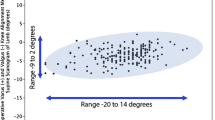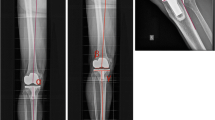Abstract
Previous studies have noted an adverse relationship between implant malalignment during total knee arthroplasty (TKA) and post-operative pain. Although some evidence exists indicating that computer-assisted surgical navigation for TKA can improve the accuracy of component alignment, its impact on clinical outcomes is currently unknown. The dual goals of the present cohort/nested case–control study were to (1) compare self-reported responses to the Western Ontario-McMaster Osteoarthritis Index (WOMAC) questionnaire between computer-assisted TKA (123 patients) using the imageless PiGalileo navigation system and conventional TKA (207 patients) [cohort analysis], and (2) to investigate a potential association between malalignment and post-operative pain in 19 painful knees and 19 asymptomatic knees obtained from the cohort analysis using matched sampling [nested case–control study]. In the cohort analysis, a relevant but non-significant (P = 0.06) difference in the occurrence of chronic pain was observed between the navigated (12%) and conventional arms (20%). Median post-operative WOMAC pain score was 100 (range, 50–100) in the conventional group and 100 (range, 65–100) in the navigated group. However, the Mann–Whitney test revealed a significant difference in favor of the navigated group (P = 0.01). In the nested case–control analysis, radiological outcomes and computer tomography (CT) measurements of femoral rotation were compared between the groups. The CT rotation measurements yielded evidence of a relationship between post-operative pain and incorrect rotational alignment of the femoral component of more than 3° (OR: 7; 95% CI: 1.2–42; P = .033). In conclusion, there was no clinical benefit to computer-assisted navigation; however, a statistically significant relationship was observed between incorrect rotational alignment of the femoral component and symptoms of post-operative pain following TKA.





Similar content being viewed by others
References
Barrack RL, Schrader T, Bertot AJ, Wolfe MW, Myers L (2001) Component rotation and anterior knee pain after total knee arthroplasty. Clin Orthop Relat Res 392:46–55
Bauwens K, Matthes G, Wich M et al (2007) Navigated total knee replacement. A meta-analysis. J Bone Joint Surg Am 89:261–269
Bellamy N, Buchanan WW, Goldsmith CH, Campbell J, Stitt LW (1988) Validation study of WOMAC: a health status instrument for measuring clinically important patient relevant outcomes to antirheumatic drug therapy in patients with osteoarthritis of the hip or knee. J Rheumatol 15:1833–1840
Callaghan JJ, Liu SS, Warth LC (2006) Computer-assisted surgery: a wine before its time: in the affirmative. J Arthroplast 21(4 Suppl. 1):27–28
Chauhan SK, Scott RG, Breidahl W, Beaver RJ (2004) Computer-assisted knee arthroplasty versus a conventional jig-based technique. A randomised, prospective trial. J Bone Joint Surg Br 86:372–377
Chin PL, Yang KY, Yeo SJ, Lo NN (2005) Randomized control trial comparing radiographic total knee arthroplasty implant placement using computer navigation versus conventional technique. J Arthroplast 20:618–626
Cobb J, Henckel J, Gomes P et al (2006) Hands-on robotic unicompartmental knee replacement: a prospective, randomised controlled study of the acrobot system. J Bone Joint Surg Br 88:188–197
Decking R, Markmann Y, Fuchs J, Puhl W, Scharf HP (2005) Leg axis after computer-navigated total knee arthroplasty: a prospective randomized trial comparing computer-navigated and manual implantation. J Arthroplast 20:282–288
Fuiko R, Zembsch A, Loyoddin M, Ritschl P (2003) Osteointegration and implant position after cementless total knee replacement. Clin Orthop Relat Res 408:201–208
Haaker RG, Stockheim M, Kamp M, Proff G, Breitenfelder J, Ottersbach A (2005) Computer-assisted navigation increases precision of component placement in total knee arthroplasty. Clin Orthop Relat Res 433:152–159
Hofmann S, Romero J, Roth-Schiffl E, Albrecht T (2003) Rotational malalignment of the components may cause chronic pain or early failure in total knee arthroplasty. Orthopade 32:469–476
Knutson K, Lindstrand A, Lidgren L (1986) Survival of knee arthroplasties: a nation-wide multicenter investigation of 8000 cases. J Bone Joint Surg Br 68:795–803
Lotke PA, Ecker ML (1977) Influence of positioning of prosthesis in total knee replacement. J Bone Joint Surg Am 59:77–79
Macule-Beneyto F, Hernandez-Vaquero D, Segur-Vilalta JM et al (2006) Navigation in total knee arthroplasty. A multicenter study. Int Orthop 30:536–540
Mason JB, Fehring TK, Estok R, Banel D, Fahrbach K (2007) Meta-analysis of alignment outcomes in computer-assisted total knee arthroplasty surgery. J Arthroplast 22:1097–1106
Matziolis G, Krocker D, Weiss U, Tohtz S, Perka C (2007) A prospective, randomized study of computer-assisted and conventional total knee arthroplasty. Three-dimensional evaluation of implant alignment and rotation. J Bone Joint Surg Am 89:236–243
Moreland JR (1988) Mechanisms of failure in total knee arthroplasty. Clin Orthop Relat Res 266:49–64
Nafei A, Kristensen O, Knudsen HM, Hvid I, Jensen J (1996) Survivorship analysis of cemented total condylar knee arthroplasty: a long-term follow-up report on 348 cases. J Arthroplast 11:7–10
Picard F, Deakin AH, Clarke JV, Dillon JM, Gregori A (2007) Using navigation intraoperative measurements narrows range of outcomes in TKA. Clin Orthop Relat Res 463:50–57
Ritter MA (1997) Postoperative pain after total knee arthroplasty. J Arthroplast 12:337–339
Ritter MA, Faris PM, Keating EM, Meding JB (1994) Postoperative alignment of total knee replacement. Its effect on survival. Clin Orthop Relat Res 299:153–156
Seon JK, Song EK (2005) Functional impact of navigation-assisted minimally invasive total knee arthroplasty. Orthopedics 28(10 Suppl.):1251–1254
Sharkey PF, Hozack WJ, Rothman RH, Shastri S, Jacoby SM (2002) Insall award paper. Why are total knee arthroplasties failing today? Clin Orthop Relat Res 404:7–13
Tingart M, Luring C, Bathis H, Beckmann J, Grifka J, Perlick L (2008) Computer-assisted total knee arthroplasty versus the conventional technique: how precise is navigation in clinical routine? Knee Surg Sports Traumatol Arthrosc 16:44–50
Ulrich SD, Mont MA, Bonutti PM, Seyler TM, Marker DR, Jones LC (2007) Scientific evidence supporting computer-assisted surgery and minimally invasive surgery for total knee arthroplasty. Expert Rev Med Devices 4:497–505
Victor J, Hoste D (2004) Image-based computer-assisted total knee arthroplasty leads to lower variability in coronal alignment. Clin Orthop Relat Res 428:131–139
Acknowledgments
This study was supported by Smith and Nephew Orthopaedics AG, Switzerland. The authors thank John David Watson, New York, for his editorial comments.
Author information
Authors and Affiliations
Corresponding author
Rights and permissions
About this article
Cite this article
Czurda, T., Fennema, P., Baumgartner, M. et al. The association between component malalignment and post-operative pain following navigation-assisted total knee arthroplasty: results of a cohort/nested case–control study. Knee Surg Sports Traumatol Arthrosc 18, 863–869 (2010). https://doi.org/10.1007/s00167-009-0990-y
Received:
Accepted:
Published:
Issue Date:
DOI: https://doi.org/10.1007/s00167-009-0990-y




